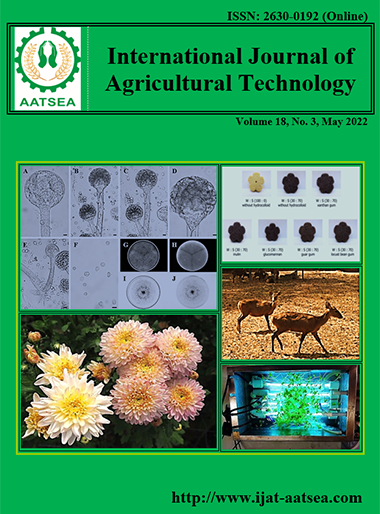Application of Allium hirtifolium for the selection process in architecture and environmental sciences
Main Article Content
Abstract
Contrary to the popular belief, green space is not just a plant-covered, tabulated area. It is a symbol of a community's cultural and social thinking. So, its scope does not include just parks. Plants are the most important environmental variables in the landscape architecture and green space. Given the numerous problems in the field of green space, it seems necessary to provide methods for selecting plants with a systemic and holistic perspective. The genus Allium is one of the largest world florae. This study analyzed the karyotype and chromosome structure in five populations of Allium hirtifolium in different parts of Van, Turkey. Pre-treatment, fixation, hydrolysis and staining were done using root meristem; then microscopic samples were elucidated. The results showed that in all studied cells of each population, the basic chromosome number was 2n=2x=16 and all of them were diploid and X=8. Karyotype analysis of each population. It was also separately conducted and several indices including length of the long arm, length of the short arm, length of satellites, total length of the chromosome, arm ratio and centromere index. The length of chromosomes in all populations was estimated as 12.53 – 18.64 micrometers. Chromosomes 6 and 8 contained a secondary constriction and satellite. Karyotype formula for these populations was seven metacentric one submetacentric
Article Details

This work is licensed under a Creative Commons Attribution-NonCommercial-NoDerivatives 4.0 International License.
References
Baghalian, K., Ziaee, A., Naghavi, M. and Naghdibady, H. S. (2004). Evaluation of Allium ecotypes Iranian culture allicin content and botanical characteristics. Medicinal plant journal, 4:50-59.
Farsi, M., Ghabooli, M. and Mahmoodnia, M. (2011). Plant cytogenetics. Mashhad University Press, Mashhsd, Iran.
Friesen, N., Fritsch, R. M. and Blattner, F. R. (2006). Phylogeny and new intrageneric classification of Allium (Alliaceae) based on nuclear ribosomal DNA ITS sequences, Aliso, 22:372-395.
Fritsch, R. M. and Friesen, N. (2002). Evolution, domestication, and taxonomy. In: Rabinowitch HD, Currah L, editors. Allium Crop Science. Recent Advances. Wallingford, UK: CABI Publishing, pp.5-30.
Fritsch, R. M. and Khassanov, F. O. (2008). New taxa of Allium L. subg. Allium (Alliaceae) from Tajikistan and Uzbekistan. Feddes Reportorium, 119:625-633.
Genç, I. and Özhatay, F. N. (2014). Allium efeae (Amaryllidaceae), a new species from northwest Anatolia, Turkey. Turkish Journal of Botany, 38:1022-1025.
Guetat, A., Rosato, M., Rosselló, J. A. and Boussaid, M. (2015). Karyotype analysis in Allium roseum L. (Alliaceae) using fluorescent in situ hybridization of rDNA sites and conventional staining. Turkish Journal of Botany, 39:796-807.
Ipek, M., Ipek, A. and Simon, P. W. (2014). Testing the utility of matK and ITS DNA regions for discrimination of Allium species. Turkish Journal of Botany, 38:203-212.
Karimzadeh, G. and Paknia, R. (2010). Karyotypic study in some Iranian local Onion populations. Journal of plant physiology and breeding, 1:49-56.
Kumari, G., Gunjan, B. and Krishna, R. (2010). Karyotype studies in dominant species of Aloe from eastern India. Center of Advanced Study in Botany, Banaras Hindu University, Varanasi- 221005, India. Journal of Caryologia, 63:41-49.
Oroji Salmasi, K., Javadi, H. and Miri, S. M. (2017). Cytogenetic study of five species of Allium L. Conference on agriculture and sustainable natural resources, 1-7.
Panahandeh, J. and Mahna, N. (2012). The Karyomorphology of Allium hirtifolium Bioss., a Less Known Edible. Species from Ira Journal of Plant Physiology and Breeding, 1:53-57.
Taghizadeh, K. and Minaee, A. (2016). How to choose plants in the planning and architecture of urban green spaces. Human Geography Research, 44:127-140.
Ünal, F. and Duman, H. (2012). Cytotaxonomic studies on four Allium L. (Alliaceae) species endemic to Turkey. Caryologia, 55:175-180.
Yaghoobi, E. Malekzadeh-Shafaroudi, S. (2016). Genetic variation of Iranian ecotypes of Garlic (Allium sp.) using karyotypenalysis. Modern Genetics, 8:411-422.
Yuzbasioglu, D. and Unal, F. (2004). Karyotiping, C-and Nor banding of Allium sativum in Turkey. Pakistan Journal of Botany, 36:343-349.


